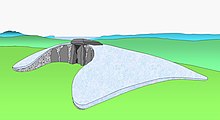Long Barrow from Lugbury
The Long Barrow of Lugbury (including Littleton Drew called) is an excavated in the 19th century megalithic neolithic chamber grave ( English chambered tombs ), the type Cotswold Severn Tomb in Littleton Drew, near the M4 in North Wiltshire in England .
There were at least 220 Cotswold Severn Tombs (about 125 preserved) in south-east Wales , Berkshire , Gloucestershire , Oxfordshire , Somerset and Wiltshire. The monuments classified by John Thurnam (1810–1873) in 1869 are between 4000 and 3000 BC. BC was built and used. The latest 14C dates of five plants in the region have shown that four of them were built around 3800 BC. Began and the use around 3625 BC. BC ended. The systems were used for about seven generations, with different periods of use.
The 0.5 m high mound is now about 50.0 m long and 15.0 m wide. At the eastern end, three upright orthostats are visible, known as cromlech since ancient times . John Aubrey (1626–1697) recorded the mound in the 17th century and found that there was a round burial mound nearby , which was plowed away around 1630.
There were two investigations in the 19th century. In 1821 Richard Colt Hoare (1758–1838) dug a trench 45.0 m long. He found that charcoal was mixed into the ground to a depth of 1.8 m, and the bottom and sides of the hill were made up of a layer of loose stones. Between the side walls, about 9.0 m west of the "Cromlech", the body burial of a young adult was discovered in a 0.6 m deep stone box , above which there was a "rude arch" (raw arch). A sharpened piece of flint lay next to the head. Colt Hoare's original manuscript shows that the original mound dimensions were approximately 66.75 m by 23.75 m. Colt Hoare believed that the primary burial was under the cromlech on the east end. In 1854 and 1855 the landowner excavated these stones. However, he did not find any burials.
The excavation of 1854 by George Julius Scrope (1797–1876) became necessary because a stone box containing several skeletons was discovered on the south side near the center of the hill while plowing. In subsequent investigations, four stone boxes with nine, ten, seven and no skeletons were discovered. There was evidence of age and gender differentiation in the boxes. John Thurnham (1810–1873) found in 1857 that Scrope had excavated the entire hill without finding any further burials.
Thurnham reported in 1868 that the southern ditch was visible as a depression. The trenches are not the subject of records. New magnetometry has indicated flanking ditches / pits to the north and south of the hill. The magnetic anomalies suggest a series of interconnected depressions showing elongated trenches with occasional interruptions. In contrast, no clear evidence of an internal structure was found, this supported the complete excavation in the middle of the 19th century.
literature
- John Thurnam: On a cromlech-tumulus called Lugbury, near Littleton Drew . Wiltshire archaeological Magazine 3, 1869, pp. 164-173.
- Timothy C. Darvill: Megalithic chambered tombs of the Cotswold-Severn Region. An assessment of certain architectural elements and their relation to ritual practice and Neolithic society . Vorda, Highworth 1982, ISBN 0-907246-04-4 ( Vorda research series 5).
- Timothy C. Darvill: Long barrows of the Cotswolds and surrounding areas . Stroud, Tempus, 2004. ISBN 0752429078
- Frances Lynch: Megalithic tombs and Long Barrows in Britain . Shire, Princes Risborough 1997, ISBN 0-7478-0341-2 ( Shire archeology 73).
Web links
Coordinates: 51 ° 30 ′ 20.6 " N , 2 ° 14 ′ 43" W.


